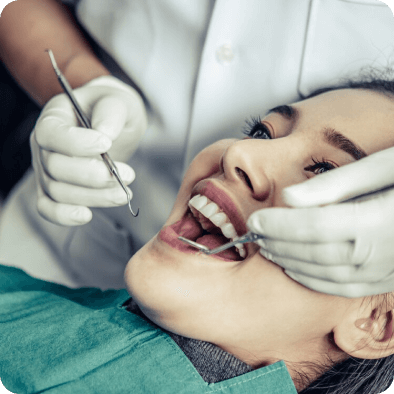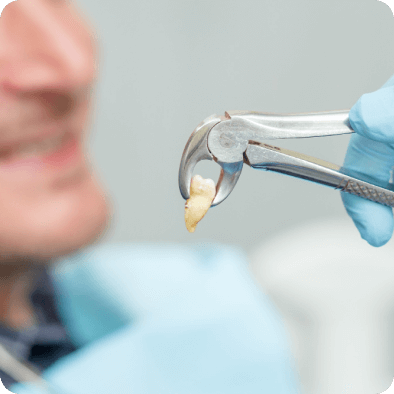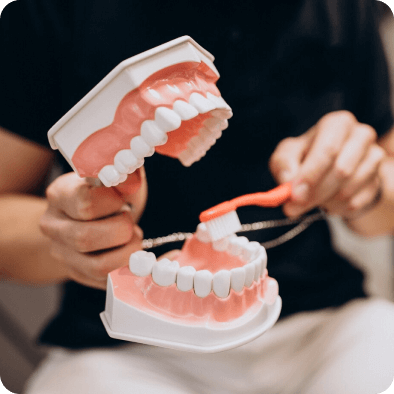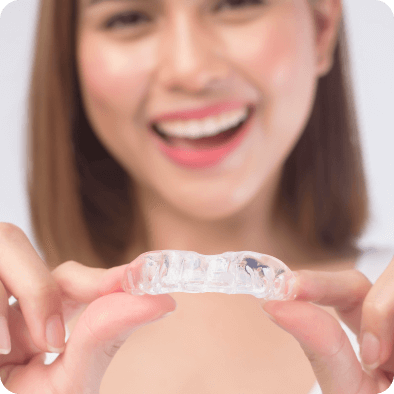Abscess: A collection of pus, usually forms due to infection.
Abutment: A tooth or tooth structure responsible for anchoring a bridge or a denture.
Amalgam: A silver filling material.
Anesthetic: An agent that causes temporary loss of sensation/feeling.
Anterior: The front position.
Apex: The end of the root.
Asepsis: No micro-organism.
Attrition: Wear of teeth due to activities such as chewing.
Avulsed: An injury where a tooth is completely knocked out.
Bitewing: A dental x-ray used to detect cavities between teeth and bone height.
Bleaching: Whitening of teeth.
Bridge: A prosthesis used to replace missing teeth.
Bruxism: Teeth grinding.
Canine: The third tooth from the middle, the longest teeth in humans.
Canker Sore: An ulceration in the mouth caused by trauma or herpes simplex.
Caries: Tooth decay.
Cavity: A hole in the tooth.
Cast: A model of teeth.
Cementation: The process of attaching a prosthesis to its location.
Chlorhexidine: An anti-microbial agent used to control gum diseases.
Clasp: A metal arm extended from a removable partial denture to hold onto natural teeth.
Cold Sore: A blister on the lip, a form of herpes simplex.
Composite: White filling material.
Cross-Bite: Abnormal bite alignment where lower teeth align toward the cheek side more than upper teeth.
Crown: A “cap” that covers a tooth to restore its function and appearance.
Decay: Softened tooth material caused by bacterial demineralization.
Dentistry: A branch of medicine dealing with the diagnosis and treatment of dental diseases.
Dentition: The position, type, and number of teeth.
Denture: An artificial replacement for missing teeth.
Denturist: A professional who fabricates dentures.
Desensitization: A procedure to reduce tooth sensitivity.
Diagnosis: The process of identifying a dental disease.
Diastema: The space between two adjacent teeth.
Distal: Direction away from the center of the jaw.
Edentulous: The condition of having no teeth.
Endodontics: A branch of dentistry that treats dental pulp.
Eruption: The process of a tooth emerging in the mouth.
Excision: The act of cutting something off.
Extruded: A tooth partially pushed out of its socket.
Filling: A restoration placed in a tooth to restore function and appearance.
Flipper: A temporary denture used during a waiting period for treatment.
Floss: A thread used to clean between teeth.
Fluoride: A compound that strengthens teeth.
Fluoride Treatment: A treatment with fluoride agents to prevent tooth decay.
Fracture: A crack in the tooth.
Framework: The metal skeleton of a removable partial denture.
Gingivitis: Inflammation of the gums, the earliest stage of gum disease.
Hemorrhage: Bleeding.
Hemostasis: The stopping of bleeding.
Impaction: When a tooth is stuck beneath another tooth or bone.
Implant: A device inserted into the jaw bone to support a false tooth.
Impression: A mold taken from the teeth.
Incisal: The cutting edge of the front teeth.
Incisor: The four upper and lower front teeth.
Inlay: A restoration that fits inside a cavity like a puzzle piece.
Interproximal: The space between two adjacent teeth.
Lingual: The side of the tooth facing the tongue.
Mesial: The side of the tooth facing the middle of the jaw.
Molar: The last three upper and lower teeth.
Mouthguard: A device worn to protect teeth during grinding or sports.
Nightguard: A mouthguard worn at night.
Occlusal: The biting surface of the back teeth.
Occlusion: How the upper and lower teeth come together.
Onlay: A restoration that covers the entire biting surface of a tooth.
Open Bite: A bite where the upper and lower teeth don’t meet.
Orthodontics: A field of dentistry focused on bite abnormalities.
Overbite: The overlap of upper and lower teeth when they close.
Overhang: A portion of filling material extending beyond the cavity.
Palate: The roof of the mouth.
Panoramic Radiograph: An x-ray film showing the full upper and lower jaw.
Perforation: An opening in a tooth or structure.
Periapical: The area surrounding the bottom of the root of a tooth.
Periodontics: A specialty in treating gum diseases.
Permanent Teeth: Adult teeth.
Pin: A metal piece used for better retention of a filling.
Polish: The process of smoothing and glossing a tooth or restoration.
Pontic: The false tooth in a bridge or denture.
Post: A pin used to support a buildup on a tooth.
Posterior: Located at the back.
Pre-authorization: Approval from an authority before treatment.
Pre-medication: Medication taken before treatment.
Premolar: Teeth located in front of the molars.
Prescription: A written order for medication or appliance preparation.
Primary Teeth: Baby teeth.
Prophylaxis/Prophy: Teeth cleaning and disease prevention procedure.
Prosthesis: An artificial part to replace missing teeth.
Prosthodontics: A dental specialty focused on artificial replacements for missing teeth.
Pulp: The innermost part of a tooth, containing nerves and blood vessels.
Pulpectomy: The removal of the entire pulp of a tooth.
Pulpotomy: The removal of part of the pulp of a tooth.
Radiograph: An x-ray picture.
Recall: Regular checkup and teeth cleaning appointment.
Recementation: The process of reattaching a prosthesis.
Restoration: An item used to restore tooth function, such as a filling or crown.
Retainer: A device used to maintain tooth position after orthodontic treatment.
Retreatment: Repeating a root canal treatment.
Root: The bottom part of a tooth that anchors it to the jaw.
Root Canal: The canal inside the tooth containing nerves and blood vessels.
Root Canal Treatment: A treatment for the root canal inside a tooth.
Root Planing: The process of cleaning the root area of teeth.
Rubber Dam: A rubber sheet isolating the treatment area from the mouth.
Scaling: Cleaning below the gumline.
Sealant: A plastic layer applied to grooves to prevent cavities.
Sedation: The use of medication to calm a patient.
Space Maintainer: An appliance that maintains space between teeth.
Splint: A device or material used to prevent movement of a mobile part.
Temporomandibular Joint (TMJ): The joint linking the two parts of the jaw.
Torus: An outgrowth of bone, often on the roof of the mouth.
Veneer: A layer of tooth-colored material that improves the appearance of a tooth.






